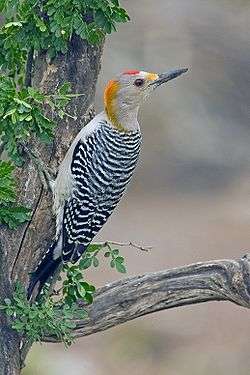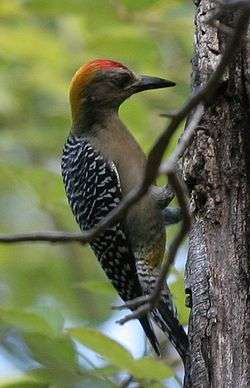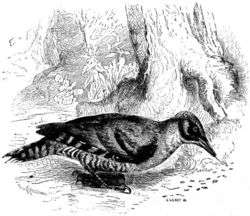Picinae
| Woodpeckers | |
|---|---|
 | |
| Hispaniolan woodpecker | |
| Scientific classification | |
| Kingdom: | Animalia |
| Phylum: | Chordata |
| Class: | Aves |
| Order: | Piciformes |
| Family: | Picidae |
| Subfamily: | Picinae Bonaparte 1838 |
| Genera | |
|
Several, see text. | |
Woodpeckers are near passerine birds of the order Piciformes. They are one subfamily in the family Picidae, which also includes the piculets and wrynecks. They are found worldwide and include about 180 species.
Woodpeckers gained their English name because of the habit of some species of tapping and pecking noisily on tree trunks with their beaks and heads. This is both a means of communication to signal possession of territory to their rivals, and a method of locating and accessing insect larvae found under the bark or in long winding tunnels in the tree or upright log.
Physiology and behaviour
Some woodpeckers and wrynecks in the order Piciformes have zygodactyl feet, with two toes pointing forward, and two backward. These feet, though adapted for clinging to a vertical surface, can be used for grasping or perching. Several species have only three toes. The woodpecker's long tongue, in many cases as long as the woodpecker itself, can be darted forward to capture insects. The tongue is not attached to the woodpecker's head in the same way as it is in most birds, but instead it curls back up around its skull, which allows it to be so long.
The woodpecker first locates a tunnel by tapping on the trunk with its head. Once a tunnel is found, the woodpecker chisels out wood until it makes an opening into the tunnel. Then it worms its tongue into the tunnel to try to locate the grub. The tongue of the woodpecker is long and ends in a barb. With its tongue the woodpecker skewers the grub and draws it out of the trunk.
Woodpeckers also use their beaks to create larger holes for their nests which are 15–45 cm (6–18 inches) below the opening. These nests are lined only with wood chips and hold 2–8 white eggs. Because the nests are out of sight, they are not visible to predators and eggs do not need to be camouflaged. Cavities created by woodpeckers are also reused as nests by other birds, such as grackles, starlings, some ducks and owls, and mammals, such as tree squirrels.
Several adaptations combine to protect the woodpecker's brain from the substantial pounding that the pecking behaviour causes: it has a relatively thick skull with relatively spongy bone to cushion the brain; there is very little cerebrospinal fluid in its small subarachnoid space; the bird contracts mandibular muscles just before impact, thus transmitting the impact past the brain and allowing its whole body to help absorb the shock; its relatively small brain is less prone to concussion than other animals'.[1]
Some species have modified joints between bones in the skull and upper jaw, as well as muscles which contract to absorb the shock of the hammering. Strong neck and tail-feather muscles, and a chisel-like bill are other hammering adaptations which are seen in most species. Other species of woodpecker, such as the Flicker, uses its long tongue primarily to grab prey from the ground or from under loose bark. It has few shock-absorbing adaptations, and prefers to feed on the ground or to chip away at rotting wood and bark, habits observed in birds outside of the woodpecker family. A "continuum" in skull structures, from little- to highly specialized for pounding is seen in different genera (groups of related species) of woodpeckers alive today. In his classic "Birds of America," John James Audubon describes the slight gradations in hyoid horn length found in different species of living woodpeckers. The slack of tongue is kept under the loose skin behind its neck. The tiny bones divide into essentially two tongues, coming back together before entering the beak.
Systematics
The systematics of woodpeckers is quite convoluted. Based on an assumption of unrealistically low convergence in details of plumage and behavior, 5 subfamilies were distinguished. However, it has turned out that similar plumage patterns and modes of life are not reliable to determine higher phylogenetic relationships in woodpeckers, and thus only 3 subfamilies should be accepted.
For example, the genera Dryocopus (Eurasia and Americas) and Campephilus (Americas) of large woodpeckers were believed to form a distinct group. However, they are quite unrelated and instead close to a Southeast Asian genus, Mulleripicus and Chrysocolaptes, respectively. In addition, the genus allocation of many species, e.g. the rufous woodpecker, has turned out to be in error, and some taxa with unclear relationships could be placed into the phylogeny.[2][3]
Unassigned fossil forms
- Genus Palaeonerpes (Ogalalla Early Pliocene of Hitchcock County, USA) - possibly dendropicine
- Genus Pliopicus (Early Pliocene of Kansas, USA) - possibly dendropicine
- cf. Colaptes DMNH 1262 (Early Pliocene of Ainsworth, USA) - possibly malarpicine
Species in taxonomic order
This is a list of woodpecker species, presented in taxonomic order.
Tribe Dendropicini


- Genus Melanerpes
- White woodpecker, Melanerpes candidus
- Lewis' woodpecker, Melanerpes lewis
- Guadeloupe woodpecker, Melanerpes herminieri
- Puerto Rican woodpecker, Melanerpes portoricensis
- Red-headed woodpecker, Melanerpes erythrocephalus
- Acorn woodpecker, Melanerpes formicivorus
- Yellow-tufted woodpecker, Melanerpes cruentatus
- Yellow-fronted woodpecker, Melanerpes flavifrons
- Golden-naped woodpecker, Melanerpes chrysauchen
- Beautiful woodpecker, Melanerpes pulcher
- Black-cheeked woodpecker, Melanerpes pucherani
- White-fronted woodpecker, Melanerpes cactorum
- Hispaniolan woodpecker, Melanerpes striatus
- Jamaican woodpecker, Melanerpes radiolatus
- Golden-cheeked woodpecker, Melanerpes chrysogenys
- Gray-breasted woodpecker, Melanerpes hypopolius
- Yucatan woodpecker, Melanerpes pygmaeus
- Red-crowned woodpecker, Melanerpes rubricapillus
- Gila woodpecker, Melanerpes uropygialis
- Hoffmann's woodpecker, Melanerpes hoffmannii
- Golden-fronted woodpecker, Melanerpes aurifrons
- Velasquez's woodpecker, Melanerpes santacruzi
- Red-bellied woodpecker, Melanerpes carolinus
- West Indian woodpecker, Melanerpes superciliaris
- Genus Sphyrapicus
- Williamson's sapsucker, Sphyrapicus thyroideus
- Yellow-bellied sapsucker, Sphyrapicus varius
- Red-naped sapsucker, Sphyrapicus nuchalis
- Red-breasted sapsucker, Sphyrapicus ruber
- Genus Xiphidiopicus
- Cuban woodpecker, Xiphidiopicus percussus (Placement in Dendropicini tentative)
- Genus Dendropicos
- Little grey woodpecker, Dendropicos elachus
- Speckle-breasted woodpecker, Dendropicos poecilolaemus
- Abyssinian woodpecker, Dendropicos abyssinicus
- Cardinal woodpecker, Dendropicos fuscescens
- Gabon woodpecker, Dendropicos gabonensis
- Melancholy woodpecker, Dendropicos lugubris
- Stierling's woodpecker, Dendropicos stierlingi
- Bearded woodpecker, Dendropicos namaquus
- Fire-bellied woodpecker, Dendropicos pyrrhogaster
- Golden-crowned woodpecker, Dendropicos xantholophus
- Elliot's woodpecker, Dendropicos elliotii
- Grey woodpecker, Dendropicos goertae
- African grey-headed woodpecker, Dendropicos spodocephalus
- Olive woodpecker, Dendropicos griseocephalus
- Brown-backed woodpecker, Dendropicos obsoletus
- Genus Dendrocopos
- Sulawesi woodpecker, Dendrocopos temminckii
- Philippine woodpecker, Dendrocopos maculatus
- Brown-capped pygmy woodpecker, Dendrocopos nanus
- Sunda woodpecker, Dendrocopos moluccensis
- Grey-capped pygmy woodpecker, Dendrocopos canicapillus
- Japanese pygmy woodpecker, Dendrocopos kizuki
- Brown-fronted woodpecker, Dendrocopos auriceps
- Fulvous-breasted woodpecker, Dendrocopos macei
- Stripe-breasted woodpecker, Dendrocopos atratus
- Yellow-crowned woodpecker, Dendrocopos mahrattensis
- Arabian woodpecker, Dendrocopos dorae
- Rufous-bellied woodpecker, Dendrocopos hyperythrus
- Darjeeling woodpecker, Dendrocopos darjellensis
- Crimson-breasted woodpecker, Dendrocopos cathpharius
- Middle spotted woodpecker, Dendrocopos medius
- White-backed woodpecker, Dendrocopos leucotos
- Great spotted woodpecker, Dendrocopos major
- Syrian woodpecker, Dendrocopos syriacus
- White-winged woodpecker, Dendrocopos leucopterus
- Sind woodpecker, Dendrocopos assimilis
- Himalayan woodpecker, Dendrocopos himalayensis

- Genus Picoides - this genus is in need of revision (Moore et al., 2006). See the genus article for more.
- Small group
- Lesser spotted woodpecker, Picoides minor - previously Dendrocopos
- Downy woodpecker, Picoides pubescens
- Nuttall's woodpecker, Picoides nuttallii
- Ladder-backed woodpecker, Picoides scalaris
- Large group
- Red-cockaded woodpecker, Picoides borealis
- Smoky-brown woodpecker, Picoides fumigatus
- Hairy woodpecker, Picoides villosus
- White-headed woodpecker, Picoides albolarvatus
- Strickland's woodpecker, Picoides stricklandi
- Arizona woodpecker, Picoides arizonae
- Three-toed group (Picoides sensu stricto)
- Eurasian three-toed woodpecker, Picoides tridactylus
- American three-toed woodpecker, Picoides dorsalis
- Black-backed woodpecker, Picoides arcticus
- Genus Veniliornis
- Red-rumped woodpecker, Veniliornis kirkii
- Golden-collared woodpecker, Veniliornis cassini
- Choco woodpecker, Veniliornis chocoensis
- Yellow-eared woodpecker, Veniliornis maculifrons
- Red-stained woodpecker, Veniliornis affinis
- Bar-bellied woodpecker, Veniliornis nigriceps
- Scarlet-backed woodpecker, Veniliornis callonotus
- Yellow-vented woodpecker, Veniliornis dignus
- Little woodpecker, Veniliornis passerinus
- Dot-fronted woodpecker, Veniliornis frontalis
- Blood-colored woodpecker, Veniliornis sanguineus
- White-spotted woodpecker, Veniliornis spilogaster
- Striped woodpecker, Veniliornis lignarius
- Checkered woodpecker, Veniliornis mixtus
Tribe Malarpicini
- Genus Campethera
- Fine-spotted woodpecker, Campethera punctuligera
- Nubian woodpecker, Campethera nubica
- Bennett's woodpecker, Campethera bennettii
- Reichenow's woodpecker, Campethera scriptoricauda
- Golden-tailed woodpecker, Campethera abingoni
- Mombasa woodpecker, Campethera mombassica
- Knysna woodpecker, Campethera notata
- Little green woodpecker, Campethera maculosa
- Green-backed woodpecker, Campethera cailliautii
- Tullberg's woodpecker, Campethera tullbergi
- Buff-spotted woodpecker, Campethera nivosa
- Brown-eared woodpecker, Campethera caroli
- Genus Geocolaptes
- Ground woodpecker, Geocolaptes olivaceus
- Genus Dinopium
- Olive-backed woodpecker, Dinopium rafflesii
- Himalayan flameback, Dinopium shorii
- Common flameback, Dinopium javanense
- Black-rumped flameback, Dinopium benghalense
- Genus Meiglyptes
- Buff-rumped woodpecker, Meiglyptes tristis
- Javan buff-rumped woodpecker, Meiglyptes tristis tristis - extinct (c.1920)
- Black-and-buff woodpecker, Meiglyptes jugularis
- Buff-necked woodpecker, Meiglyptes tukki
- Buff-rumped woodpecker, Meiglyptes tristis
- Genus Hemicircus (Placement in Malarpicini tentative)
- Grey-and-buff woodpecker, Hemicircus concretus
- Heart-spotted woodpecker, Hemicircus canente
- Genus Micropternus (formerly in Celeus)
- Rufous woodpecker, Micropternus brachyurus
Tribe Picini
- Genus Picus
- Banded woodpecker, Picus mineaceus
- Lesser yellownape, Picus chlorolophus
- Crimson-winged woodpecker, Picus puniceus
- Greater yellownape, Picus flavinucha
- Checker-throated woodpecker, Picus mentalis
- Streak-breasted woodpecker, Picus viridanus
- Laced woodpecker, Picus vittatus
- Streak-throated woodpecker, Picus xanthopygaeus
- Scaly-bellied woodpecker, Picus squamatus
- Japanese green woodpecker, Picus awokera
 Green woodpecker searching for insects, depicted in Scientific American Supplement, No. 492, June 6, 1885
Green woodpecker searching for insects, depicted in Scientific American Supplement, No. 492, June 6, 1885 - European green woodpecker, Picus viridis
- Iberian green woodpecker, Picus sharpei
- Levaillant's woodpecker, Picus vaillantii
- Red-collared woodpecker, Picus rabieri
- Black-headed woodpecker, Picus erythropygius
- Grey-headed woodpecker, Picus canus
- Genus Mulleripicus
- Ashy woodpecker, Mulleripicus fulvus
- Sooty woodpecker, Mulleripicus funebris
- Great slaty woodpecker, Mulleripicus pulverulentus
- Genus Dryocopus
- Helmeted woodpecker, Dryocopus galeatus
- Lineated woodpecker, Dryocopus lineatus
- Pileated woodpecker, Dryocopus pileatus
- Black-bodied woodpecker, Dryocopus schulzi
- White-bellied woodpecker, Dryocopus javensis
- Andaman woodpecker, Dryocopus hodgei
- Black woodpecker, Dryocopus martius
- Genus Celeus
- Cinnamon woodpecker, Celeus loricatus
- Scaly-breasted woodpecker, Celeus grammicus
- Waved woodpecker, Celeus undatus
- Chestnut-colored woodpecker, Celeus castaneus
- Chestnut woodpecker, Celeus elegans
- Pale-crested woodpecker, Celeus lugubris
- Blond-crested woodpecker, Celeus flavescens
- Cream-colored woodpecker, Celeus flavus
- Rufous-headed woodpecker, Celeus spectabilis
- Caatinga woodpecker, Celeus obrieni
- Ringed woodpecker, Celeus torquatus
- Genus Piculus
- Rufous-winged woodpecker, Piculus simplex
- Stripe-cheeked woodpecker, Piculus callopterus
- Lita woodpecker, Piculus litae
- White-throated woodpecker, Piculus leucolaemus
- Yellow-throated woodpecker, Piculus flavigula
- Golden-green woodpecker, Piculus chrysochloros
- Yellow-browed woodpecker, Piculus aurulentus
- Genus Colaptes
- Golden-olive woodpecker, Colaptes rubiginosus
- Gray-crowned woodpecker, Colaptes auricularis
- Crimson-mantled woodpecker, Colaptes rivolii
- Black-necked woodpecker, Colaptes atricollis
- Spot-breasted woodpecker, Colaptes punctigula
- Green-barred woodpecker, Colaptes melanochloros
- Golden-breasted woodpecker, Colaptes (melanochloros) melanolaimus
- Northern flicker, Colaptes auratus
- Yellow-shafted Flicker, Colaptes (auratus) auratus
- Red-shafted Flicker, Colaptes (auratus) cafer
- Guadalupe Flicker, Colaptes auratus/cafer rufipileus - extinct (c.1910)
- Gilded flicker, Colaptes chrysoides
- Fernandina's flicker, Colaptes fernandinae
- Chilean flicker, Colaptes pitius
- Andean flicker, Colaptes rupicola
- Campo flicker, Colaptes campestris
Tribe Megapicini
- Genus Campephilus
- Powerful woodpecker, Campephilus pollens
- Crimson-bellied woodpecker, Campephilus haematogaster
- Red-necked woodpecker, Campephilus rubricollis
- Robust woodpecker, Campephilus robustus
- Crimson-crested woodpecker, Campephilus melanoleucos
- Guayaquil woodpecker, Campephilus gayaquilensis
- Pale-billed woodpecker, Campephilus guatemalensis
- Cream-backed woodpecker, Campephilus leucopogon
- Magellanic woodpecker, Campephilus magellanicus
- Ivory-billed woodpecker, Campephilus principalis (possibly extinct)
- Imperial woodpecker, Campephilus imperialis (possibly extinct)

- Genus Chrysocolaptes
- White-naped woodpecker, Chrysocolaptes festivus
- Greater flameback, Chrysocolaptes lucidus
- Genus Reinwardtipicus
- Orange-backed woodpecker, Reinwardtipicus validus
- Genus Blythipicus
- Maroon woodpecker, Blythipicus rubiginosus
- Bay woodpecker, Blythipicus pyrrhotis
- Genus Gecinulus (Placement in Megapicini tentative)
- Pale-headed woodpecker, Gecinulus grantia
- Bamboo woodpecker, Gecinulus viridis
- Genus Sapheopipo (Placement in Megapicini tentative)
- Okinawa woodpecker, Sapheopipo noguchii
References
- ↑ Cure for a headache, Ivan R. Schwab, British Journal of Ophthalmology. 86(8):843, August 2002.
- ↑ Evolutionary history of woodpeckers and allies (Aves: Picidae): Placing key taxa on the phylogenetic tree, Molecular Phylogenetics and Evolution, Brett W. Benz, Mark B. Robbins and A. Townsend Peterson Volume 40, Issue 2, August 2006, Pages 389-399
- ↑ Mitochondrial DNA phylogeny of the woodpecker genus Veniliornis (Picidae, Picinae) and related genera implies convergent evolution of plumage patterns, Biological Journal of the Linnean Society, William S. Moore, Amy C. Weibel and Andrea Aguis Volume 87 Issue 4 Page 611-624, April 2006
External links
| Wikimedia Commons has media related to Picidae. |
- Woodpecker videos on the Internet Bird Collection
- Anatomy and Evolution of the Woodpecker's Tongue